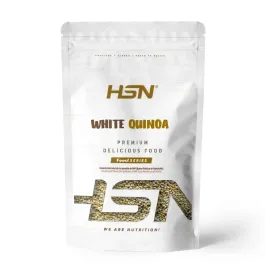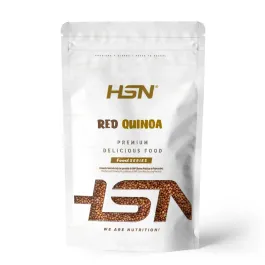- Quinoa is the pseudocereal that will become your new favourite source of carbs.
- An ideal food thanks to its nutritional profile: Rich in complex carbohydrates, with a good amount of protein and fibre.
- Gluten-free: Quinoa is the perfect carb source for coeliacs. That's because it contains no gluten.
- Highly versatile and adaptable: Enjoy it as a side dish, main meal, or as an ingredient in your recipes. Get creative with quinoa.
- Looking for the most special variety of quinoa? - If you're after the most intense quinoa, black quinoa is for you.
Black quinoa – Perfect as a side dish
Black quinoa from FoodSeries is a HSN food product made exclusively from the black variety of quinoa seeds, with no additives.
Quinoa is a pseudocereal, which means that although it's technically a seed and not a cereal, it behaves like one. It’s used similarly to rice, and that’s why it’s a go-to base and side dish in countless international recipes, especially in Indian cuisine.
Discover what makes this the boldest variety of quinoa.
Are you adventurous? Then black quinoa is for you!
But first... What is quinoa?
Quinoa is an Andean seed considered a pseudocereal due to its consumption being similar to traditional cereals. A source of high-quality protein, rich in fibre and other key nutrients, and naturally gluten-free, it's earned a well-deserved place in healthy diets around the globe. In the kitchen, quinoa is extremely versatile: it can be used in salads, as a side, in soups, veggie burgers, and even in sweet dishes like biscuits or desserts, thanks to its mild flavour and slightly crunchy texture that suit many meals.
Originally from the Andes and cultivated for over 5,000 years, quinoa was a staple food for civilisations like the Incas, who regarded it as a sacred grain. Its global rediscovery in recent decades has led to research into its different varieties – with white, red and black being the most notable. Black quinoa is the least common, known for its firmer texture, earthier taste, and high nutritional density. Black quinoa is not an ancient wild species, but the result of natural evolution and selection among traditional varieties, developed to improve agricultural adaptability and enhance biodiversity in this cherished food crop.
Black quinoa is the most intense variety
Black quinoa is the most intense variety of this ancient pseudocereal, making it especially valued in cooking and nutrition. Its flavour is more complex, with nuances that stand out in savoury dishes and contrast beautifully in sweet recipes. Its texture is much firmer, which gives it a unique presence in salads, bowls and veggie mixes. Nutritionally, it's known for its higher antioxidant content, especially anthocyanins, which give it its dark colour. This intensity in both flavour and benefits makes it an excellent choice for those looking for richer culinary experiences and foods with greater nutritional value.
If you want a quick and visual comparison of the quinoa varieties, take a look at the following table:
| | White quinoa | Red quinoa | Black quinoa |
| Colour | Beige / Ivory | Reddish / Dark brown | Black |
| Flavour | Mild and neutral | Moderate | Intense |
| Texture | Soft and fluffy | Firm and crunchy | Very firm and hard |
| Cooking time | 10-15 min | 15-20 min | 20-25 min |
| Recommended use | All kinds of recipes | Salads and poke bowls | Vegan burgers and side dishes |
| Nutritional value | Good source of protein and fibre | Higher fibre content | Similar to red quinoa |
Gluten-free. Guaranteed!
As a pseudocereal, quinoa is excellent because it offers the typical nutritional benefits of starchy cereals in terms of complex carbohydrate quantity and quality, but it’s naturally free of prolamins (gluten), making it completely suitable for coeliacs and non-allergic gluten-intolerant people.
At HSN, we don't just 'choose gluten-free ingredients'. We follow a certified chain-of-custody process that ensures not only that quinoa is gluten-free by nature, but that no gluten is introduced through cross-contamination. This guarantees complete compatibility with gluten-free dietary needs.
How does black quinoa stand out in meals?
Black quinoa stands out in dishes thanks to its distinct flavour and firm texture, setting it apart from softer varieties. It has a deeper taste, with earthy and slightly toasted notes that add character and complexity to meals. Its crunchier consistency stays even after cooking, creating a great contrast when combined with softer or creamier ingredients. This firmness also helps keep the grains separate and defined, enhancing both the eating experience and presentation.
Thanks to these qualities, black quinoa shines in dishes where texture and bold flavour are key. It’s perfect for warm or cold salads, served with boiled veggies, nuts or soft cheeses, as it stands out without overpowering the other ingredients. It also works brilliantly in energy bowls with pulses, avocado and bold sauces, or as a filling base for stuffed veg. You can even use it in veggie burger or croquette mixes, as it adds structure without needing binders or additives.
Its presence on the plate doesn’t go unnoticed and brings a gourmet touch to everyday meals, with no need to reinvent the recipe.
Is it a good option as part of your diet?
It’s a fantastic choice, as every 100g of product provides:
- 15g of protein: Complete. With all essential amino acids.
- 7g of fibre: Important in Western diets, where fruit and veg are sadly becoming less common.
- 64g of carbohydrates: Mainly complex, with low sugar content, ideal for long-lasting energy.
Don’t forget to rinse quinoa! Why?
This is especially important with black quinoa, as its nutrient content makes it more noticeable.
Quinoa has natural saponins on its surface – compounds that offer no nutritional or functional value but can give a bitter taste if the quinoa isn't rinsed before cooking. By rinsing quinoa, you remove a good portion of these saponins, making it taste much smoother and better, so don’t skip this step.
 Before
Before After
After During
During Morning
Morning Afternoon
Afternoon Night
Night Before
Before After
After During
During Morning
Morning Afternoon
Afternoon Night
Night Before
Before After
After During
During Morning
Morning Afternoon
Afternoon Night
Night















